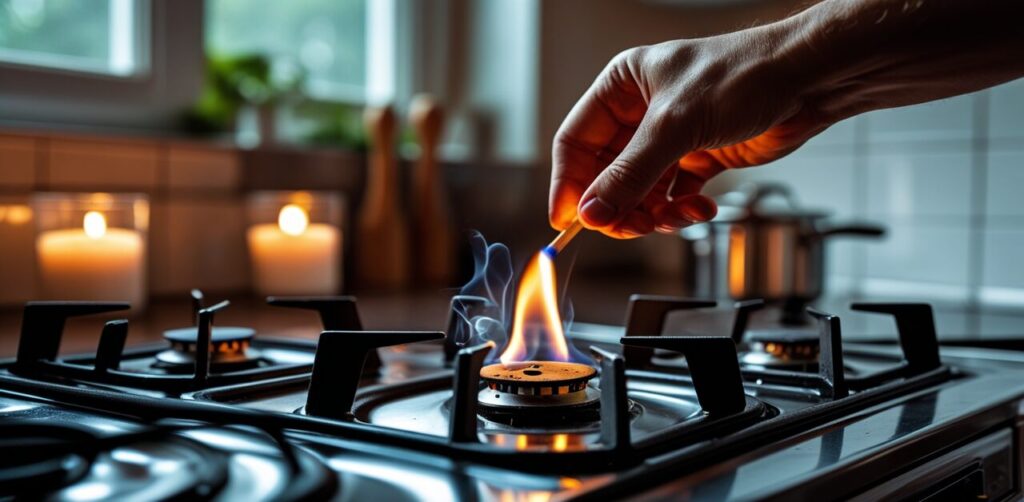Gas stoves hold a reliable place in the heart of many homeowners and culinary enthusiasts. They offer precision cooking that’s hard to beat and work well in various settings, such as busy family kitchens or serene off-grid cabins. But if you’re caught in a power outage and your gas stove relies on an electronic ignition system, the question inevitably arises—can you still light it?
The answer? Yes, you can! This guide will walk you through the mechanics of gas stoves, emergency lighting methods, and essential safety tips to help you cook confidently, even without electricity.
Understanding Gas Stoves
How Does a Gas Stove Work?
Gas stoves use a simple mechanism to produce heat. They connect to a fuel source like natural gas or propane, which flows to the burner. Once ignited, the gas produces a flame that directly heats your cookware, giving you precise temperature control.
Many modern gas stoves are equipped with an electronic ignition system, which uses electricity to produce the spark needed to ignite the gas. This is why a power outage may leave you wondering how to get your stove running.
Types of Gas Stove Ignition Systems
- Electronic Ignition
- Found in most modern gas stoves.
- Relies on electricity for ignition.
- Pilot Light Ignition
- Found in older gas stove models.
- Uses a small, continuously burning flame as the ignition source.
If your stove has a pilot light, power outages won’t disrupt your cooking. But for those with electronic ignition, you’ll need an alternative method.
Emergency Lighting Methods
Without electricity, lighting a gas stove takes a bit of manual effort, but it’s easy when done correctly. Here’s a step-by-step guide to get you cooking again.
How to Light a Gas Stove Without Electricity
Tools Needed
- Long-handled lighter or match
- A responsible approach to safety
Steps
- Turn the gas knob: Turn the burner knob to the “ignite” or “light” position. You’ll hear the gas flowing.
- Ignite the gas: Bring a lit match or long-handled lighter close to the burner head.
- Adjust the flame: Once the gas ignites, carefully adjust the flame to your desired level.
Pro Tip: Use a long-handled lighter rather than matches to keep your hands a safe distance from the flames during ignition.
Alternative Tools
- Butane Torch: A reliable way to light your stove if you’re comfortable using one.
- Manual Piezo Igniter: A portable, battery-free tool capable of creating a spark to ignite gas manually.
Sustainability and Energy Efficiency
Gas stoves are not just practical in emergencies; they’re also remarkably energy-efficient.
Energy-Saving Benefits of Gas Stoves
- Lower energy consumption: Gas stoves are more cost-effective to operate compared to electric stoves.
- Precision control: They allow fine adjustments to flame size, reducing wasted heat.
- Minimal heat loss: Gas stoves heat cookware more directly, increasing overall cooking efficiency.
Tips for Maximizing Efficiency
- Use the right-sized burner for your pots and pans.
- Regularly clean burners to ensure optimal flame performance.
- Install a low-flow regulator to control gas consumption.
Safety Precautions and Maintenance
When lighting a gas stove manually, safety must be your top priority. Missteps can lead to dangerous accidents, so following proper precautions is crucial.
Safety Tips for Emergency Lighting
- Always ensure proper ventilation while using your stove to prevent gas build-up.
- Never leave gas knobs turned on without ignition.
- Avoid using faulty lighters or tools, as they can cause accidental fires.
Maintenance Practices
- Check for gas leaks: Inspect your gas lines regularly for damage or leakage—use a soapy water solution to detect bubbles around connections.
- Clean burner heads: Residue buildup can block gas flow and result in uneven flames.
- Service regularly: Hire a professional technician to inspect your stove semi-annually.
Practical Use and Real-World Scenarios
Gas stoves have proven indispensable in various settings, from off-grid cabins to bustling restaurant kitchens. Here’s what real users have to say about their experiences.
Homeowner Story
“I live in a hurricane-prone area, and power outages are common. My gas stove has saved me countless times during storms. Even when it’s pitch dark outside, I can still prepare meals for my family with ease.” – Emily T., Florida
Chef’s Perspective
“Cooking precision is critical in professional kitchens, and gas stoves offer unparalleled control. Learning how to light one manually isn’t just practical—it’s essential for any chef.” – David L., Executive Chef
Off-Grid Enthusiast Insight
“Our cabin operates completely off-grid, and our propane stove works flawlessly without electricity. Knowing how to light it by hand was a game-changer—it adds so much flexibility.” – Sarah M., Off-Grid Advocate
FAQs
1. Is it safe to manually light a gas stove during emergencies?
Yes, it’s safe as long as you follow appropriate precautions, such as proper ventilation and using suitable ignition tools like long-handled lighters.
2. Can all gas stoves be lit without electricity?
Most gas stoves with electronic ignition can be lit manually. However, always refer to your stove’s user manual for specific instructions.
3. What should I do if I smell gas while trying to light my stove?
Immediately turn off all knobs, ventilate your kitchen, and contact your gas provider. Do not attempt to light the stove until the source of the leak is addressed.
4. Are gas stoves energy-efficient compared to electric stoves?
Yes, gas stoves consume less energy, offer precise temperature control, and heat cookware more efficiently than electric stoves.
Why Gas Stoves Shine in Emergencies
Gas stoves prove their worth not only in everyday cooking but also during unexpected power outages or off-grid adventures. Knowing how to light your stove without electricity is a life skill that adds safety, convenience, and efficiency to your kitchen routine.
Whether you’re a homeowner, a chef, or an off-grid enthusiast, the ability to cook on a gas stove in any scenario is a tool worth having in your arsenal. Got questions, tips, or experiences to share? We’d love to hear from you—drop a comment below or share your story!



